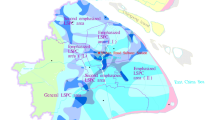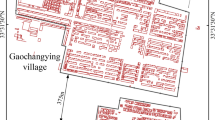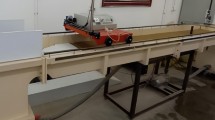Abstract
Abandoned salt caverns, particularly those that allow free draining of brine, are serious potential causes of subsidence above salt mines. Filling such caverns with alkali wastes may eliminate these troubles. Based on the filling project in Jingshen salt mine of China, the influences of filling abandoned free-draining salt caverns with alkali wastes on surface subsidence are discussed. The deposition characteristics of alkali waste slurry were studied by laboratory simulation tests. It is found that alkali waste slurry has good flowability during injection into a cavern. Based on the results of compression tests under drained conditions, a distribution model of void ratio of sediment is established. A method for determining the ultimate subsidence value is presented based on the distribution model. The relationship of average effective stress and void ratio of the sediment is also established. Further, a method for predicting development process of surface subsidence is presented. Finally, the specific application procedure of the prediction methods is discussed. According to the research results, filling free-draining salt caverns with alkali wastes can restrain surface subsidence successfully. The reasons can be summed up as: Volume convergence of salt caverns slows down after the caverns are filled owing to the supporting effect of alkali wastes on the rock surrounding caverns, and then, subsidence slows down and decreases, and finally, subsidence stops when the fill material is compacted to its compressed limit.























Similar content being viewed by others
References
Argonne National Laboratory (2003) An introduction to slurry injection technology for disposal drilling wastes. Argonne National Laboratory, Argonne USA
Bauer S, Beyer C, Dethlefsen F, Dietrich P, Duttmann R, Ebert M, Feeser V, Görke U, Köber R, Kolditz O, Rabbel W, Schanz T, Schäfer D, Würdemann H, Dahmke A (2013) Impacts of the use of the geological subsurface for energy storage: an investigation concept. Environ Earth Sci 70(8):3935–3943
Bérest P, Brouard B (2003) Safety of salt caverns used for underground storage. Oil Gas Sci Technol 58(3):361–384
Davidson B, Dusseault MB, Demers R (1997) Solution cavern placement of Solvay process solids—development and implementation of cavern placement technology. In: SMRI Meeting paper, Fall, 1997. El Paso, Texas, USA. Solution Mining Research Institute
Hoather HA, Challinor D (1994) The use of salt cavities for the disposal of wastes. In: Meeting SMRI (ed) Paper. Solution Mining Research Institute, Hannover
Hou Z, Wundram L, Meyer R, Schmidt M, Schmitz S, Were P (2012) Development of a long-term wellbore sealing concept based on numerical simulations and in situ-testing in the Altmark natural gas field. Environ Earth Sci 67(2):395–409
Itasca (2005) FLAC3D version 3.0 manual. Itasca Consulting Group, Inc, Minneapolis
Langer M (1993) Underground disposal of wastes requiring special monitoring in salt rock masses. In: Proceedings of 3rd Conference on the mechanical behavior of salt. Germany: Clausthal-Zellerfeld Press, pp 583–603
Norton FH (1929) Creep of steel at high temperatures. McGraw-Hill Book Company, New York
Tomasko D, Elcock D, Veil J, Caudle D (1997) Risk analyses for disposing nonhazardous oil field wastes in salt cavern. Report prepared for US Department of Energy
Veil JA (1996) Preliminary technical and legal evaluation of disposing of nonhazardous oil field waste into salt caverns. Final Report. Albuquerque, New Mexico USA: Sandia National Laboratory
Veil JA (1997) Costs for off-site disposal of nonhazardous oil field wastes: salt caverns versus other disposal methods. Report prepared for US Department of Energy
Veil JA, Elcock D, Raivel M, Caudle D, Ayers RC (1996) Preliminary technical and legal evaluation of disposing of Nonhazardous oil field waste into salt caverns. Report prepared for US Department of Energy
Veil JA, Smith KP, Tomasko D, Elcock D, Blunt DL, Williams GP (1998) Disposal of NORM-Contaminated oil field wastes in salt cavern. Report prepared for US Department of Energy
Wang TT, Yan XZ, Yang HL, Jiang TT, Zhao S, Yang X (2013) A new shape design method of salt cavern used as underground gas storage. Appl Energy 104c:50–61
Wareen JK (2006) Evaporites: sediments, resources and hydrocarbons. Springer, New York
Xu YL, Yang CH, Li YP, Guo YT, Ji WD (2012) Preliminary study of the interaction between backfill body and surrounding rock salt mass. In: Bérest P, Ghoreychi M, Hadj-Hassen F, Tijani M (eds) Mechanical behaviour of salt VII. CRC Press, Boca Raton, pp 293–301
Yang CH, Li YP, Chen F (2009) Mechanics theory and engineering of bedded salt rock. Science Press, Beijing (in Chinese)
Acknowledgments
The authors would like to acknowledge Dr. J. J. K. Daemen, who is a professor at the University of Nevada, USA, for his very useful help in English language. Also the authors would gratefully like to acknowledge the financial support from National Natural Science Foundation of China (No. 51404241, 51304187, 41472285, 41272391, 51274187), National Basic Research Program of China (973 Program) (No. 2009CB724600), and Jiangsu Jingshen Salt Chemical Stock Company Limited.
Author information
Authors and Affiliations
Corresponding author
Rights and permissions
About this article
Cite this article
Shi, X., Li, Y., Yang, C. et al. Influences of filling abandoned salt caverns with alkali wastes on surface subsidence. Environ Earth Sci 73, 6939–6950 (2015). https://doi.org/10.1007/s12665-015-4135-y
Received:
Accepted:
Published:
Issue Date:
DOI: https://doi.org/10.1007/s12665-015-4135-y




